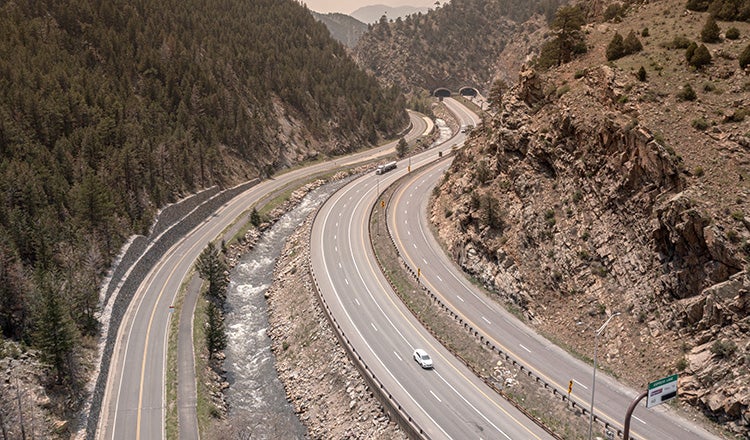I-70 Floyd Hill Improvements

I-70 Floyd Hill Improvements
8 Miles of Interstate Upgrades in Colorado’s Mountains
- Added lanes and frontage road to improve travel time reliability, safety
- More than 10,000 feet of bridges and nearly 4 miles of retaining walls
- Close collaboration with contractor through construction manager/general contractor (CM/GC) delivery method
The Colorado Department of Transportation’s (CDOT) I-70 Floyd Hill project will improve 8 miles of the interstate in the state’s mountain corridor from west of Evergreen to eastern Idaho Springs. I-70 is a critical lifeline for Colorado, serving as both as eastbound and westbound freight routes and connecting the state’s Front Range to its mountain communities, recreational areas, and resorts, all key economic drivers.
To improve safety and provide for more reliable travel times, the $700 million Floyd Hill project will improve horizontal curves; widen westbound I-70 to add a third, tolled lane; add an eastbound auxiliary lane to reduce conflicts with slow-moving truck traffic in the uphill section; construct a missing 2-mile section of the frontage road between interchanges; improve intersections; and provide the Greenway Trail along Clear Creek in compliance with the Americans with Disabilities Act (ADA). Early projects include two wildlife crossings and roundabouts at two intersections.
HDR is serving as the overall structures lead and the lead for rockfall mitigation as a major teaming partner. We also led roadway design for the project’s east section.
A Need for Improvement
Currently, the area sees over 100 crashes per year and high congestion, particularly during peak weekend travel periods. Drivers are often gridlocked for hours, making it a challenge to reach many of the state’s premier destinations and difficult and costly to move freight. Local traffic and emergency vehicles are also reliant on the interstate because the I-70 frontage road has a missing 2-mile connection between Exits 243 and 244.
Westbound vehicles from Denver, destined for Colorado’s mountains on I-70, climb nearly 2,000 feet in elevation to the top of Floyd Hill. There, traffic lanes are reduced from three westbound lanes to two, creating a bottleneck effect. Traffic then descends steeply from Floyd Hill to Clear Creek and the I-70/US 6 interchange, dropping 600 feet in less than 2 miles. This stretch poses unique risks to drivers due to tight turns, limited sight distances, congestion and inconsistent travel speeds. Motorists make a sharp turn on the bridge structure over Clear Creek before navigating several miles of tight canyon turns and a nontraditional left-merge lane for traffic merging onto I-70 westbound from US 6 before reaching the Veterans Memorial Tunnels where the existing Westbound I-70 Mountain Express Lane starts and the bottleneck ends.
Ongoing Focus on Collaboration
The project is being delivered through the construction manager/general contractor delivery method, which prioritizes collaboration between the contractor and designer to optimize cost and facilitate constructability.
The delivery method means that HDR works for the owner and the contractor works for the owner but the contractor and our team also work closely together to determine constructable and cost-effective solutions. The final project is being delivered through three packages — east, central and west sections.
The collaboration continued beyond the CM/GC. As part of the mountain corridor, the project used CDOT’s context sensitive solutions process. Throughout the design process, groups of stakeholders — including community leaders, landowners, users, technical professionals and more — worked closely with the project team to assist in decision making. These groups reviewed and evaluated alternatives, reviewed environmental impacts and discussed mitigation options.

Designing Bridges and Roads Through the Mountains
Because of the mountain setting, creative solutions had to be employed to improve the highway geometry and fit the structures into a limited amount of space. The project involves more than 10,000 feet of bridges and nearly 4 miles of retaining walls.
Multiple structure types are employed based on what will work best for each section, including cast-in-place segmental bridges with balanced cantilever construction and spliced concrete girders. We are serving as lead designer for the largest bridge on the project, which is more than a mile long and will carry westbound traffic around Floyd Hill.
Our team provided extensive design services to help CDOT meet its budget needs amid cost inflation. We offered creative solutions such as adjustments to the bridge design while keeping the project on schedule.
On the east section, accommodating drainage along the road’s 7% profile grade was a challenge. Our roadway engineers worked closely with drainage and geotechnical engineers to provide adequate capacity while limiting the amount of rock excavation to keep costs down and construction moving.
Delivering a Better Experience for Users
The Floyd Hill project will improve safety, reduce congestion, improve travel time reliability, and support multimodal travel for local and regional traffic, including freight traffic on an important segment of the National Highway Freight Network’s Primary Highway Freight System.
Construction began on the east section in mid-2023 and the west section in 2024. The central section featuring most of the bridges is scheduled to begin construction in 2025. When work is finished — expected in 2029 — the new road will deliver more reliable travel times and a safer experience for visitors, freight and commuters alike.




